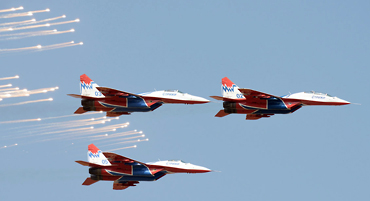The Russian Air Force originated in 1912 and was referred to as Voyenno-Vozdushnye Sily and was the official designation of the Air Forces of the Soviet Union.
The Boslhevik All-Russia Collegium for Direction of the Air Forces was formed on 20 December 191. After a general postwar military reorganization, the collegium was reconstituted as the "Workers' and Peasants' Red Air Fleet" (Glavvozduhflot), established on 24 May 1918 and given the top-level departmental status of "Main Directorat. It became the Directorate of the USSR Air Forces on 28 March 1924, and then the Directorate of the Workers-Peasants Red Army Air Forces on 1 January 1925. Initially the number of types in use were limited but with the formation of a national aircraft industry available aircraft types became more diverse.
The structure of the Air Force was organized in air armies, aviation corps, aviation divisions, and aviation regiments, composed of air squadrons, flights. Domestic aircraft production increased significantly in the early thirties and towards the end of the decade, and saw another boost directly after the Second World War.
During the war a “Lend-lease” agreement saw the integration of foreign built aircraft integrated within the Air Force, and the significance of domestic military aircraft development and manufacturing became a top priority. During the war several aircraft factories were erected and designated as OKB. In these factories developments took place towards military aviation in order to design faster, more manoeuvrable aircraft than the opponent. The current aircraft manufacturers like Tupolev, Ilyushin, Mikoyan-Guerevich (MiG), Yak, Lavochkin and Sukhoi were originated during this time. After the war was over these factories remained working on development of mainly military aviation and resulted in the first jet propelled aircraft in 1948.
The jet age started with the design of the Yak-9 and was soon succeeded by the MiG-15 of which a large number were built for air defence purposes and a two seat version for air crew training purposes. Both MiG and Sukhoi factories were focused at the development of fighter aircraft. The Tupolev aircraft factory was focused at the development of bomber and long range strategic aircraft, although Tupolev managed to developed one long range air defence fighter known as the Tu-128. and Sukhoi focused their development on fighter-bomber aircraft. Ilyushin mainly concentrated on the development of Transport aircraft.
Directly after the war the WPKA Army Air Forces became the Soviet Air Forces once again. With the capabilities increased enormously the Soviet Air Force became an independent component of the armed forces in 1949, reaching operational force status in 1954.
Cold War years
During the Cold War the VVS was divided into three main branches:
Long Range Aviation “Dal'naya Aviatsiya”or DA, focused on long-range bombing and reconnaissance missions;
Frontal Aviation “Frontovaya Aviatsiya or FA, focused on tactical aviation and air defence, close air support, and interdiction and most of the fighter and fighter bombers were appointed to this branch; and
Military Transport Aviation “Voenno-Transportnaya Aviatsiya” or VTA, which controlled all transport aircraft.
Within this structure the Soviet Air Defence Forces “Voyska protivovozdushnoy oborony” or Voyska PVO, provided air defence and interceptor aircraft, as a separate force within the Soviet military structure. Another independent service was the Soviet Naval Aviation “Aviatsiya Voenno Morskogo Flota” or AV-MF, and was subordinated under the Navy headquarters.
The Soviet tactical Air Force was engaged again when the Korean war broke out. As an ally to the Chinese and North Koreans they were engaged in fierce battles against US led United Nations coalition forces. Also in the following decades from 1960 to 1980 the tactical air force were involved in several local conflicts, when the Soviet Air Force was extending its operational area providing military assistance to nations within the sphere of influence joined under the Warsaw Pact treaty but also to nations like Cuba and several countries in the middle east. The operational strength of the FA expanded and became one of the largest air forces in the world.
In the Cold War period, the Soviet Air Force was modernized, additional aircraft for specific roles were integrated in their operational structure and modern air doctrines were introduced. During the leadership of Nikita Krushchov the expansion ended temporary since the Soviet leader believed in unmanned aircraft and ballistic missiles. This policy however was abandoned by Leonid Brezhnev who did not share his predecessor's opinion and the development of the FA became a new impulse. With the introduction of the third generation fighters in the eighties and nineties both economic and arms reductions plans led to a new decline of the Soviet and later Russian Tactical Aviation Force.
In 1977 the VVS and the Soviet Air Defence Forces were re-organised in the Baltic states and the Leningrad region, as a trial run for the larger re-organisation in 1980 covering the entire country. All fighter units in the PVO were transferred to the VVS, with the Air Defence Forces only retaining the anti-aircraft missile units and radars. Although the experiment was applied for the entire Air Forces in 1980, it was reversed in 1986, when most of the assets became part of the Air Force, as well as several educational and training institutions.











